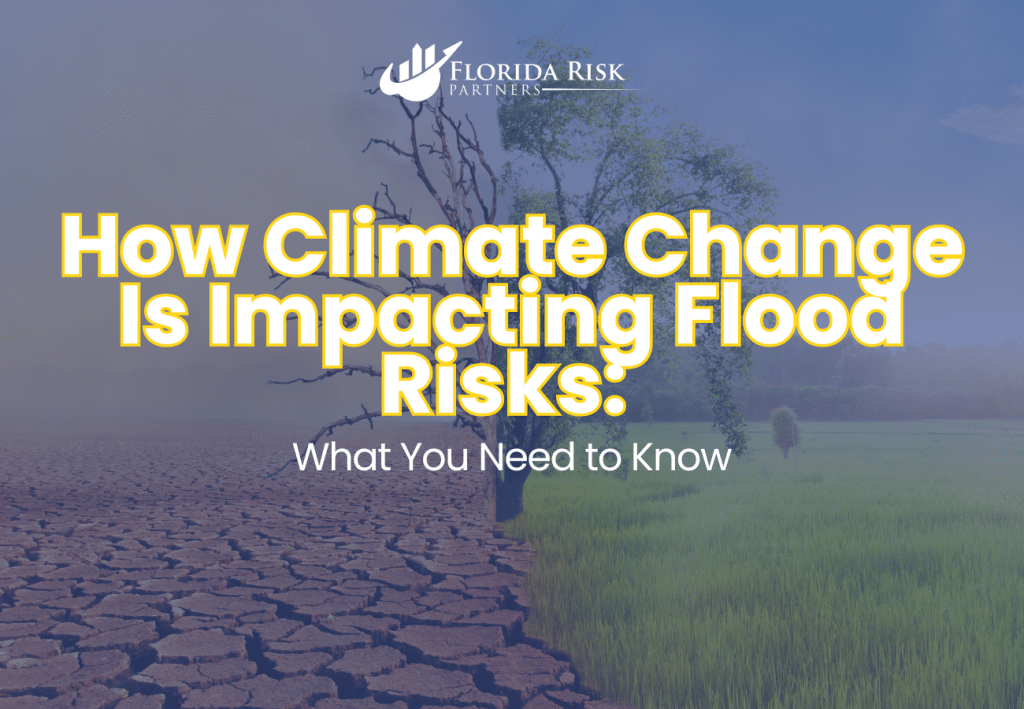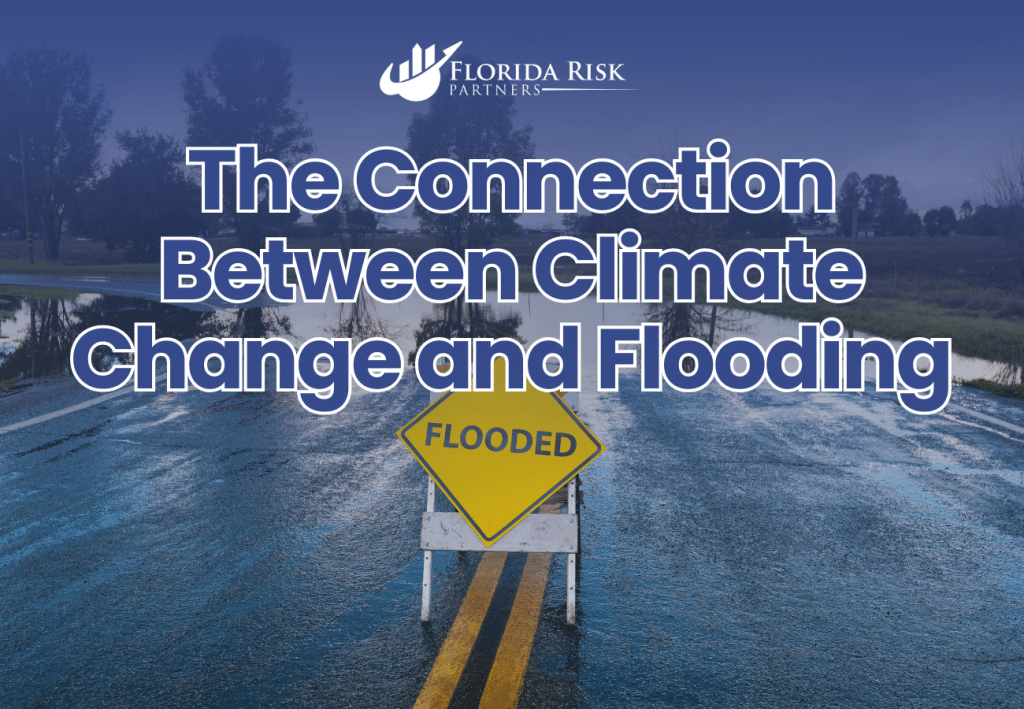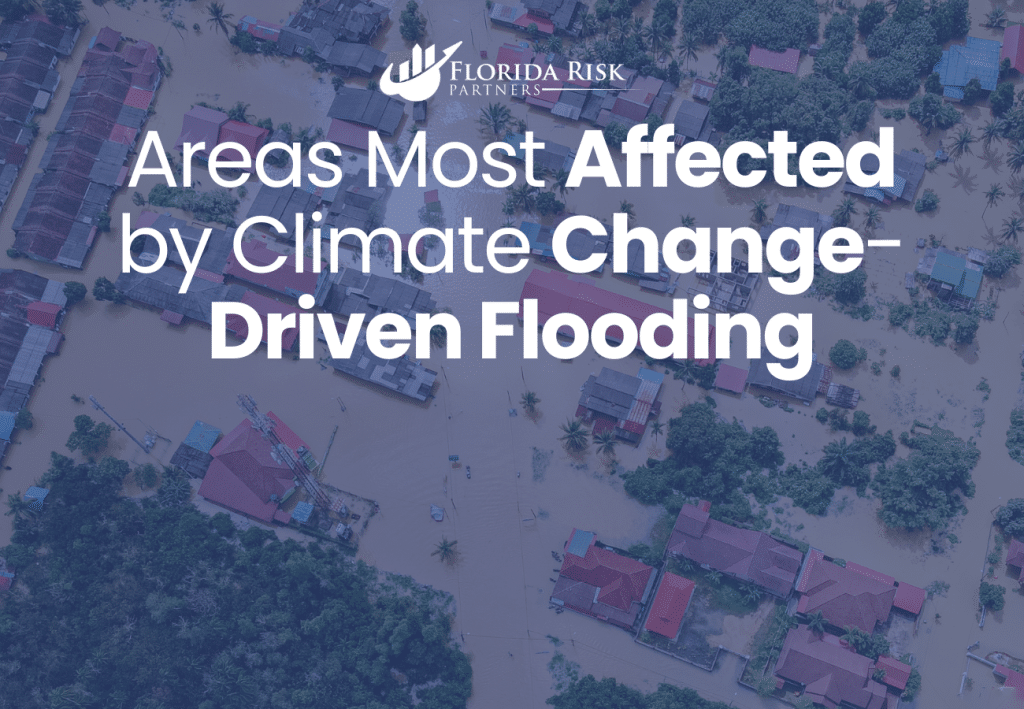-
Main Office: 1434 E. Bloomingdale Ave Valrico, FL 33596-6110
-
Phone: (888) 601-6660
-
Email: info@floridariskpartners.com

Climate change is no longer a distant threat—it’s a reality that is reshaping weather patterns and increasing the risk of natural disasters across the globe. One of the most significant consequences of climate change is the increasing frequency and severity of flooding. Whether you live in a high-risk flood zone or a low-risk area, understanding how climate change is impacting flood risks is critical for protecting your home or business. Climate change intensifies weather shifts, increasing flood risks. Discover vital flood insurance insights in this blog.
In this post, we’ll explore the connection between climate change and rising flood risks, explain how changing weather patterns are affecting flood-prone areas, and discuss what you can do to protect your property from these growing threats. This guide is part of our Flood Insurance 101 series, where we provide comprehensive information to help you prepare for the evolving risks posed by floods and other natural disasters.
The Connection Between Climate Change and Flooding
Floods have always been a natural part of the weather cycle, but climate change is intensifying these events by altering precipitation patterns, increasing the frequency of extreme weather, and contributing to rising sea levels. Let’s break down how climate change is impacting flood risks:
1. More Intense Rainfall Events
One of the most direct ways climate change is affecting flood risks is through more intense rainfall events. As the atmosphere warms, it can hold more moisture, leading to heavier downpours during storms. This means that even areas that have historically experienced moderate rainfall can now face extreme precipitation events, increasing the likelihood of flash floods and river flooding.
These heavy rains can overwhelm drainage systems, rivers, and streams, leading to flooding in both urban and rural areas. Cities with inadequate stormwater infrastructure are particularly vulnerable, as water may have nowhere to go, resulting in significant property damage. As rainfall becomes more unpredictable, areas that were once considered low-risk for flooding may now be at greater risk.
2. Rising Sea Levels and Coastal Flooding
Another significant consequence of climate change is the rise in global sea levels. According to the National Oceanic and Atmospheric Administration (NOAA), global sea levels have risen by about 8 inches since 1880, and the rate of rise is accelerating. This has serious implications for coastal areas, where higher sea levels increase the risk of coastal flooding and storm surges during hurricanes and other storms.
Coastal communities are already experiencing more frequent flooding, especially during high tides and storms. As sea levels continue to rise, the risk of chronic flooding—flooding that occurs regularly even without major storms—will increase, putting millions of homes and businesses at risk.

3. Melting Snow and Ice
In regions that rely on snowpack for water supply, climate change is causing earlier snowmelt, which can lead to spring flooding. As temperatures rise, snow and ice melt faster, releasing large amounts of water into rivers and streams at once. This can overwhelm water management systems, leading to riverine flooding that affects communities downstream.
Additionally, the loss of glaciers and ice sheets is contributing to sea level rise, further exacerbating flood risks in coastal areas. As these ice reserves shrink, the resulting increase in ocean volume intensifies the threat of flooding for coastal cities around the world.
Areas Most Affected by Climate Change-Driven Flooding
While flooding can happen anywhere, certain areas are more vulnerable to the effects of climate change. Knowing whether you live or own a business in a high-risk area is essential for determining the steps you need to take to protect your property.
1. Coastal Communities
Coastal areas are particularly vulnerable to the impacts of rising sea levels and increased storm surges. Cities like Miami, New Orleans, and New York are already experiencing more frequent flooding, especially during hurricanes and high tides. As sea levels continue to rise, coastal flooding will become more frequent and severe, putting homes, businesses, and infrastructure at risk.
For property owners in coastal areas, flood insurance is essential for protecting against the growing risk of flooding. Learn more about how flood insurance protects coastal properties here.
2. Urban Areas with Poor Drainage
Cities and urban areas with inadequate drainage systems are at increased risk of flooding due to heavy rainfall events. As climate change causes more intense storms, the lack of sufficient drainage infrastructure can lead to urban flooding, where water quickly accumulates in streets and homes.
These areas may not have been considered high-risk in the past, but changing weather patterns are forcing cities to reassess their flood risk. Urban property owners should consider investing in flood insurance to protect against this emerging threat. Get a flood insurance quote here to see how affordable protection can be.
3. Inland Areas Near Rivers
Inland areas located near rivers and streams are vulnerable to riverine flooding, particularly as climate change leads to more frequent and intense rainfall. Rivers that once handled seasonal water flows may now overflow their banks more often, causing extensive damage to nearby communities.
Additionally, earlier snowmelt in mountainous regions can contribute to flooding downstream. Property owners near rivers should consider purchasing flood insurance to protect against this growing risk. Check your flood zone here to determine your level of risk.

The Financial Impact of Climate Change-Driven Flooding
The economic consequences of climate change-driven flooding are immense. As flood risks increase, so do the costs associated with flood damage, recovery, and insurance premiums. According to FEMA, flooding causes billions of dollars in damage annually in the U.S. alone, and these costs are expected to rise as climate change intensifies.
Without flood insurance, property owners may face significant out-of-pocket expenses for repairs, replacement of belongings, and temporary housing. Here are some of the hidden financial costs associated with flooding:
- Structural repairs to your home or business, including foundation and electrical system repairs.
- Mold remediation to prevent long-term health risks.
- Temporary housing costs if your property becomes uninhabitable.
- Business interruption costs for lost revenue and operational downtime.
Flood insurance provides critical financial protection against these costs, ensuring that you can recover after a flood without depleting your savings. Learn more about flood insurance coverage here.
How to Protect Your Property from Climate Change-Driven Flooding
As flood risks increase due to climate change, property owners must take proactive steps to protect their homes and businesses. Here are a few key actions you can take to minimize the impact of flooding:
1. Purchase Flood Insurance
The most important step you can take to protect your property is purchasing flood insurance. Whether you live in a high-risk flood zone or a low-risk area, flood insurance provides essential financial protection. Don’t wait until the next storm hits—get your flood insurance quote now here and ensure you’re covered.
2. Elevate Your Property
If you live in a flood-prone area, consider elevating your home or business above the base flood elevation (BFE). This can significantly reduce the risk of flood damage and may also lower your insurance premiums. Additionally, installing flood barriers, sump pumps, and drainage systems can help protect your property from rising waters.
3. Stay Informed About Flood Risks
As climate change continues to reshape weather patterns, it’s important to stay informed about the evolving flood risks in your area. Use FEMA’s Flood Map Service Center to regularly check your property’s flood zone, and consider working with a local contractor to assess your property’s vulnerability to flooding.
Conclusion: Be Prepared for Climate Change-Driven Flooding
The effects of climate change are already being felt across the globe, and flooding is one of the most immediate and costly consequences. As storms become more intense, sea levels rise, and rainfall patterns shift, it’s more important than ever to be proactive in protecting your home or business.
By understanding the connection between climate change and flood risks, and by taking steps like purchasing flood insurance, elevating your property, and staying informed about your flood zone, you can minimize the impact of future floods.
Don’t wait until it’s too late—get your flood insurance quote now here and protect your property from the growing risks of flooding.
Call Us Or
Schedule an Appointment
Select an agent below to view our online calendars and select a day and time that works best for you or call us directly at 888-601-6660. When you use our online calendars, you will receive an email with more information.



